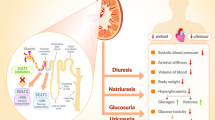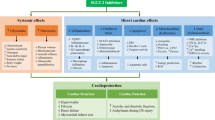Summary
Sulphonylurea derivatives are widely used in the treatment of non-insulin-dependent diabetes mellitus. The mechanism of action of the insulinotropic effect of these agents is based on the closure of adenosine-5′-triphosphate (ATP)-sensitive potassium channels (KATP-channels) in the beta cells of the pancreas. In the last decade, these KATP-channels have been demonstrated in myocardial cells as well as in vascular smooth muscle cells. During myocardial ischaemia, the KATP-channels are thought to open by a fall in the cytosolic ATP concentration. The increase in the extracellular adenosine concentration, and the release of endothelium-derived hyperpolarizing factor (EDHF) during ischaemia may further contribute to the opening of cardiovascular KATP-channels. Independently from the mechanism of opening, sulphonylurea derivatives have been reported to block the opening of cardiovascular KATP-channels. Related to the role of KATP-channel-opening in the (patho)physiology of ischaemia, the use of sulphonylurea derivatives significantly modifies the outcome of experimental myocardial infarction. Sulphonylurea derivatives impair the recovery of the contractile function and increase the ultimate infarct size in animal models. In contrast, sulphonylurea derivatives have a beneficial effect on the incidence of ventricular fibrillation as occurs after ischaemic incidents of the myocardium. Based on these experimental observations, human studies are indicated to investigate whether the use of these drugs modifies the clinical outcome of cardiovascular events in patients with non-insulin dependent diabetes mellitus. [Diabetologia (1995) 38: 116–121]
Similar content being viewed by others
Abbreviations
- KATP-channel:
-
Adenosine-5′-triphosphate dependent potassium channel
- EDHF:
-
endothelium-derived hyperpolarizing factor
- NIDDM:
-
non-insulin dependent diabetes mellitus
References
Abbot RD, Brand FN, Kannel WB (1990) Epidemiology of some peripheral arterial findings in diabetic men and women: experiences from the Framingham study. Am J Med 88: 376–381
Fuller JH, Shipley MJ, Rose G, Jarret RJ, Keen H (1983) Mortality from coronary heart disease and stroke in relation to degree of glycaemia: the Whitehall study. BMJ 287: 867–870
Hiller R, Sperduto RD, Podgor MJ, Ferris FL, Wilson PWF (1988) Diabetic retinopathy and cardiovascular disease in type II diabetics. The Framingham heart study and the Framingham eye study. Am J Epidemiol 128: 402–409
Groop LC (1992) Sulfonylureas in NIDDM: Diabetes Care 15: 737–754
Gerich JE (1989) Oral hypoglycemic agents. N Engl J Med 321: 1231–1245
Noma A (1983) ATP-regulated K-channels in cardiac muscle. Nature 305: 147–148
Standen NB, Quayle JM, Davies NW, Brayden JE, Huang Y, Nelson MT (1989) Hyperpolarizing vasodilators activate ATP-sensitive K+-channels in arterial smooth muscle. Science 245: 177–180
Edwards G, Weston AH (1990) Potassium channel openers and vascular smooth muscle relaxation. Pharmac Ther 48: 237–258
Katz AM (1993) Cardiac ion channels. N Engl J Med 328: 1244–1251
Nichols CG, Ripoll C, Lederer WJ (1991) ATP-sensitive potassium channel modulation of the guinea pig ventricular action potential and contraction. Circ Res 68: 280–287
Brayden JE (1991) Hyperpolarization and relaxation of resistance arteries in response to adenosine diphosphate. Circ Res 69: 1415–1420
Hori M, Kitakaze M (1991) Adenosine, the heart, and coronary circulation. Hypertension 18: 565–574
Kirsch GE, Codina J, Birnbaumer L, Brown AM (1990) Coupling of ATP-sensitive K-channels to A1-receptors by G proteins in rat ventricular myocytes. Am J Physiol 259: H820-H826
Milner P, Ralevic V, Hopwood AM et al. (1989) Ultrastructural localisation of substance P and choline acetyltransferase in endothelial cells of rat coronary artery and release of substance P and acetylcholine during hypoxia. Experientia 45: 121–125
Milner P, Bodin P, Loesch A, Burnstock G (1990) Rapid release of endothelin and ATP from isolated aortic endothelial cells exposed to increased flow. Bioch Biophys Res Comm 170: 649–656
Burnstock G (1990) Local mechanisms of blood flow control by perivascular nerves and endothelium. J Hypertension 8 [Suppl 7]: S95-S106
Suzuki H, Chen G, Yamamoto Y (1992) Endothelium-derived hyperpolarizing factor (EDHF). Jpn Circ J 56: 170–174
Brayden JE (1990) Membrane hyperpolarization is a mechanism of endothelium-dependent cerebral vasodilation. Am J Physiol 259: H668-H673
Meisheri KD, Khan SA, Martin JL (1993) Vascular pharmacology of ATP-sensitive K-channels: interactions between glyburide and K-channel-openers. J Vasc Res 30: 2–12
Ogawa N, Fukata Y, Kaneta S, Jinno Y, Fukushima H, Nishikori K (1992) Comparison of KRN2391 with nicorandil and nifedipine on canine coronary blood flow: antagonism by glibenclamide. J Cardiovasc Pharmacol 20: 11–17
Duncker DJ, Zon van NS, Altman JD, Pavek DJ, Bache RJ (1993) Role of KATP-channels in coronary vasodilation during exercise. Circulation 88: 1245–1253
Aversano T, Ouyang P, Silverman H (1991) Blockade of the ATP-sensitive potassium channel modulates reactive hyperemia in the canine coronary circulation. Circ Res 69: 618–622
Belloni FL, Hintze TH (1991) Glibenclamide attenuates adenosine-induced bradycardia and coronary vasodilation. Am J Phys 261: H720-H727
Yoneyama F, Yamada H, Satoh K, Taira N (1992) Vasodepressor mechanisms of 2-(1-octynyl)-adenosine (YT-146), a selective adenosine A2-receptor agonist, involve the opening of glibenclamide-sensitive potassium channels. Eur J Pharmacol 213: 199–204
Spinelli W, Sorota S, Siegal M, Hoffman BF (1991) Antiarrhythmic actions of the ATP-regulated K+-current activatied by pinacidil. Circ Res 68: 1127–1137
Murakami M, Furukawa Y, Karasawa Y, Ren L-M, Takayama S, Chiba S (1992) Inhibition by glibenclamide of negative chronotropic and inotropic responses to pinacidil, acetylcholine, and adenosine in the isolated dog heart. J Cardiovasc Pharmacol 19: 618–624
Cole WC, Mcpherson CD, Sontag D (1991) ATP-regulated K+-channels protect the myocardium against ischemia/reperfusion damage. Circ Res 69: 571–581
Auchampach JA, Maruyama M, Cavero I, Gross GJ (1992) Pharmacological evidence for a role of ATP-dependent potassium channels in myocardial stunning. Circulation 86: 311–319
Gross GJ, Auchampach JA (1992) Blockade of ATP-sensitive potassium channels prevents myocardial preconditioning in dogs. Circ Res 70: 223–233
Thornton JD, Thornton CS, Sterling DL, Downey JM (1993) Blockade of ATP-sensitive potassium channels increases infarct size but does not prevent preconditioning in rabbit hearts. Circ Res 72: 44–49
Daut J, Maier-Rudolph W, Beckerath vN, Mehrke G, Günther K, Goedel-Meinen L (1990) Hypoxic dilation of coronary arteries is mediated by ATP-sensitive potassium channels. Science 247: 1341–1344
Murroy CE, Jennings RB, Reimer KA (1986) Preconditioning with ischemia: a delay of lethal cell injury in ischemic myocardium. Circulation 74: 1124–1136
Thornton JD, Liu GS, Olsson RA, Downey JM (1992) Intravenous pretreatment with A1-selective adenosine analogues protects the heart against infarction. Circulation 85: 659–665
Toombs CF, McGee DS, Johnston WE, Vinten-Johansen J (1992) Myocardial protective effects of adenosine. Infarct size reduction with pretreatment and continued receptor stimulation during ischemia. Circulation 86: 986–994
Belle van H, Verheyen W, Ver Donck K, Janssen PAJ, Robertson JIS (1992) Prevention of catecholamine-induced cardiac damage and death with a nucleoside transport inhibitor. J Cardiovasc Pharmacol 20: 173–178
Smits P, Lenders JWM, Thien Th (1990) Caffeine and theophylline attenuate adenosine-induced vasodilation in humans. Clin Pharmacol Ther 48: 410–418
Edlund A, Siden Å, Sollevi A (1987) Evidence for an antiaggregatory effect of adenosine at physiological concentrations and for its role in the action of dipyridamole. Thromb Res 45: 183–190
Smits P, Lenders JWM, Willemsen JJ, Thien Th (1991) Adenosine attenuates the response to sympathetic stimuli in man. Hypertension 18: 216–223
Smits P, Lenders JWM, Willemsen JJ, den Arend JACJ, Thien Th (1991) Adenosine attenuates the vasoconstrictor response to the cold pressor test in humans. J Cardiovasc Pharmacol 17: 1019–1022
DiMarco JP, Sellers TD, Lerman BB, Greenberg ML, Berne RM, Belardinelli L (1985) Diagnostic and therapeutic use of adenosine in patients with supraventricular tachyarrhythmias. J Am Coll Cardiol 6: 417–425
Grover GJ, Sleph PG, Dzwoncyk BS (1992) Role of myocardial ATP-sensitive potassium channels in mediating preconditioning in the dog heart and their possible interaction with adenosine A1-receptors. Circulation 86: 1310–1316
Billman G, Avendano CE, Halliwill JR, Burroughs JM (1993) The effects of the ATP-dependent potassium channel antagonist glyburide on coronary blood flow and susceptibility to ventricular fibrillation in anaesthetized dogs. J Cardiovasc Pharmacol 21: 197–204
Sanguinetti MC (1992) Modulation of potassium channels by antiarrhythmic and antihypertensive drugs. Hypertension 19: 228–236
Tosaki A, Hellegouarch A (1994) ATP-sensitive potassium channel blocking agent ameliorates, but the opening agent aggravates, ischemia/reperfusion-induced injury. J Am Cell Cardiol 23: 487–496
Jönsson A, Rydberg T, Ekberg G, Hallengren B, Melander A (1994) Slow elimination of glyburide in NIDDM subjects. Diabetes Care 17: 142–145
Melander A, Bitzén P-O, Faber O, Groop L (1989) Sulphonylurea antidiabetic drugs. An update of their clinical pharmacology and rational therapeutic use. Drugs 37: 58–72
Stenman S, Melander A, Groop P-H, Groop LC (1993) What is the benefit of increasing the sulfonylurea dose? Ann Int Med 118: 169–172
Landry DW, Oliver JA (1992) The ATP-sensitive potassium channel mediates hypotension in endotoxemia and hypoxic lactic acidosis in dog. J Clin Invest 89: 2071–2074
Zeiher AM, Drexler H, Wollschläger H, Just H (1991) Endothelial dysfunction of the coronary microvasculature is associated with impaired coronary blood flow regulation in patients with early atherosclerosis. Circulation 84: 1984–1992
University Group Diabetes Program (1970) A study of the effects of hypoglycemic agents on vascular complications in patients with adult-onset diabetes mellitus: II. Mortality results. Diabetes 19 [Suppl 2]: 785–830
Klimt CR, Canner PHPL, Jacobs DR, Tominaga S (1977) The prognostic importance of plasma glucose levels and of the use of oral hypoglycemic drugs after myocardial infarction in men. Diabetes 26: 453–465
Soler NG, Bennet MA, Lamb P, Pentecost BL, FitzGerald MG, Malins JM (1974) Coronary care for myocardial infarction in diabetics. Lancet i: 475–477
Keen H (1971) Factors influencing the progress of atherosclerosis in the diabetic. Acta Diabetol Lat 8 [Suppl 1]: 444–456
Paasikivi J, Wahlberg F (1971) Preventive tolbutamide treatment and arterial disease in mild hyperglycaemia. Diabetologia 7: 323–327
Ohneda A, Maruhama Y, Itabashi H et al. (1978) Vascular complications and long-term administration of oral hypoglycemic agents in patients with diabetes mellitus. Tohoku J Exp Med 124: 205–222
Knowler WC, Sartor G, Scherstén B (1987) Effects of glucose tolerance and treatment of abnormal tolerance on mortality in Malmöhus County, Sweden. Diabetologia 30: 541 A (Abstract)
Persson G (1977) Cardiovascular complications in diabetics and subjects with reduced glucose tolerance. Act Med Scand [Suppl] 605: 25–37
Gilbert JP, Saracci R, Meier P, Zelen M, Rümke C, White C (1975) Report of the committee for the assessment of biometric aspects of controlled trials of hypoglycemic agents. J Am Med Assoc 231:583–608
Author information
Authors and Affiliations
Rights and permissions
About this article
Cite this article
Smits, P., Thien, T. Cardiovascular effects of sulphonylurea derivatives. Diabetologia 38, 116–121 (1995). https://doi.org/10.1007/BF02369361
Issue Date:
DOI: https://doi.org/10.1007/BF02369361




